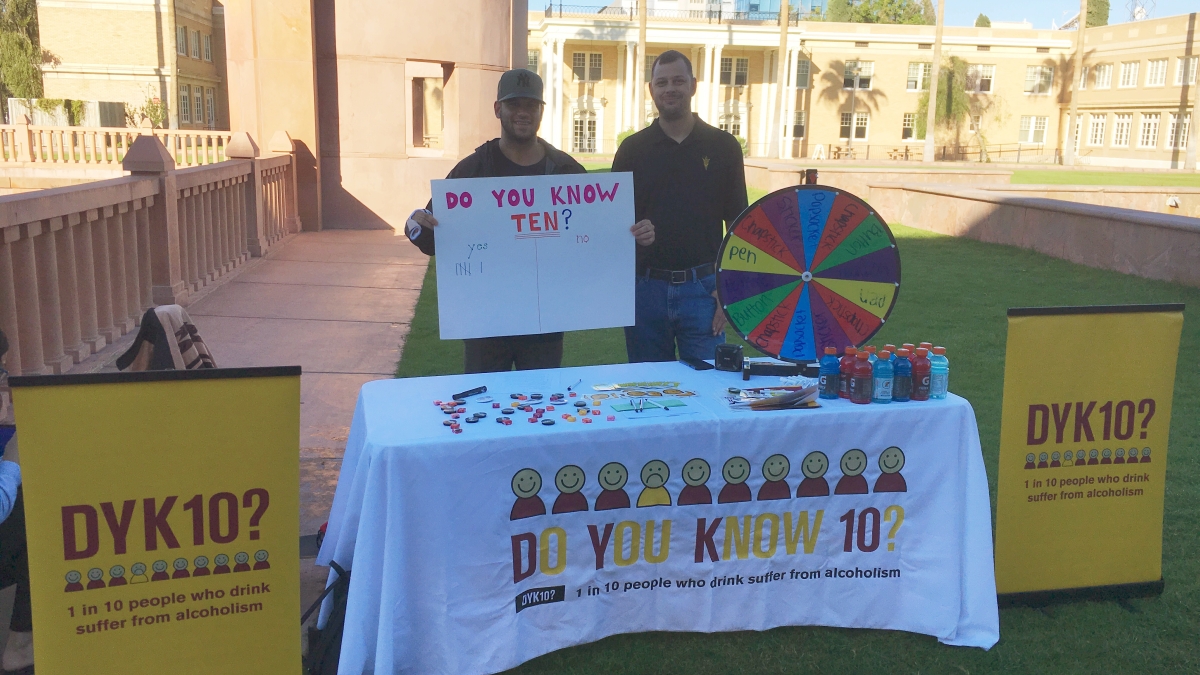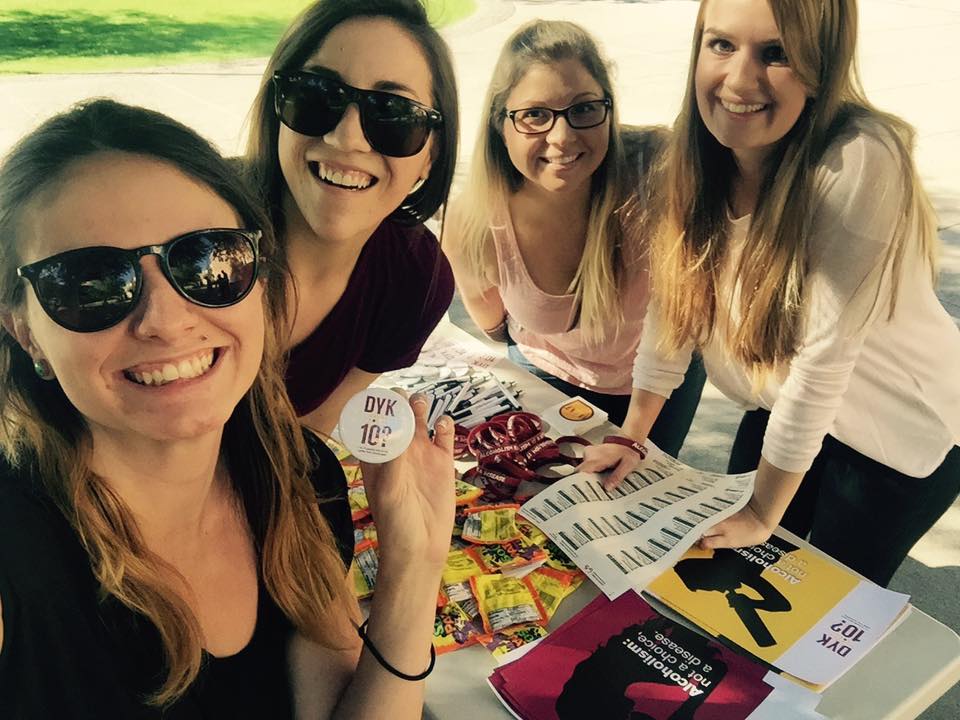Recovery from addiction … one conversation at a time

Students in Com 494: Communication, Alcoholism and Recovery hold a tabling event on the Tempe campus for the DYK10 campaign.
September is Recovery Month, a national observance designed to increase awareness and understanding of mental and substance use disorders and celebrate the people who recover. A key message is that treatment is available and recovery is possible, but overcoming the stigma of addiction is a critical first step in helping people get the support they need.
Sponsored by the Substance Abuse and Mental Health Services Administration (SAMHSA), Recovery Month sheds light on resources and programs, for individuals and families, including local treatment facilities, support groups and community-based organizations.
Many college campuses, including Arizona State University, also provide programs and resources, including on-campus counseling to students in recovery.
Unique to ASU is a course devoted to addressing alcoholism and recovery among college students.
COM 494: Communication, Alcoholism and Recovery examines the role communication plays in addiction and recovery. The course is taught each fall by Linda Lederman, professor and director of the Hugh Downs School of Human Communication, an expert on communication and substance abuse, and co-editor of "Voices of Recovery from the Campus: Stories of and by College Students in Recovery from Addiction."
“In the Hugh Downs School we study communication in everyday life,” Lederman said. “And one of the ways we look at communication is in the context of health. Not just health care, but all health issues, and addiction these days is a big health issue. Despite its prevalence across all segments of society, stigma is one of the most common barriers to treatment of alcoholism.”
Hidden population
Lederman says that college students are often a hidden population in outreach efforts because of stereotypical notions that depict alcoholics as older people.
“That’s the image that seems to go with an active alcoholic,” Lederman said. “In reality, people with alcohol-use disorder, the clinical term for the disease of alcoholism, can be anyone — a co-worker, spouse or a friend. Alcoholism does not discriminate and can affect anyone regardless of age, gender, ethnicity or socioeconomic status.”
Lederman adds that another common misperception among the public is that drinking in college is a "rite of passage" and that college students are too young to have alcoholism.
This misperception, explains Lederman, can mask a problem with alcohol use and means that people who need help may not be trying to get it.
In "Communication, Alcoholism and Recovery," students learn about the disease, get to comprehend it in depth and work on a campaign to help spread the word to others.
They work on “DYK10” (Do You Know 10), the campaign designed by the students in the class over years to educate people to the fact that, on average, one in 10 people who drink have alcoholism. To help others learn that despite this prevalence across all segments of society, feelings of shame and fear of being perceived as weak or beyond hope can serve as major barriers to seeking help.

hold a tabling event on the Tempe campus to start conversations
on the stigma of alcoholism.
Students design, roll out and measure the campaign’s effectiveness by how many people they’ve reached, both at face-to-face events and through social media.
The class comes up with innovative ways to get the DYK10 message out to the campus during the months of October and November — extending the messages from Recovery Month throughout the fall. Students present at Greek Life meetings, do walkabouts and hold tabling events on the Tempe campus.
Passersby are enticed to stop by with music, snacks and a game. Prizes include fun marketing materials that get the DYK10 message across, including PopSockets, stickers and flyers.
Students chronicle meaningful exchanges about alcohol and recovery they hear at the events. As one team member wrote in a final presentation in the course about the campaign’s success: “We are making a positive impact and starting important conversations.”
Students in Lederman’s class learn that the words they use to talk about alcoholism carry with them different images and different connotations.
“You could describe someone as an ‘alcoholic,’ or ‘someone with alcohol-use disorder’ or you can say ‘somebody with alcoholism,’” Lederman said. “It’s fine to use any of the terms but important to know the different images they convey.”
At the end of the course, not only have the students run a campaign and reached others, but they also consider themselves to be allies of people in recovery.
“It is the stigma attached to alcoholism that keeps active alcoholics from getting help for their disease,” Lederman said. “It is the stigma that keeps active alcoholics from talking more openly about their disease. The DYK10 campaign allows students to have conversations with others that help them understand that treatment is available and recovery is possible, but overcoming stigma is a critical first step in getting the support they need.”
Students in COM494 created this video for their final presentation.
More Health and medicine

Reducing waste in medical settings
Health care saves lives, but at what cost? Current health care practices might be creating a large carbon footprint,…

ASU offers bilingual counseling to Spanish speakers
Arizona is one of the five states in the nation with the highest percentage of Hispanic residents, according to the U.S.…

College of Health Solutions launches first-of-its-kind diagnostics industry partnership to train the workforce of tomorrow
From 2007 to 2022, cytotechnology certification examinees diminished from 246 to 109 per year. With only 19 programs in the…

